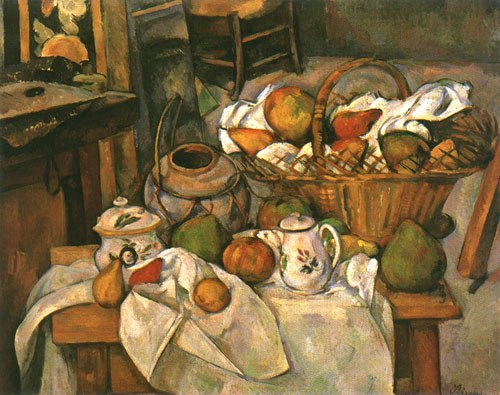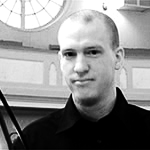

Which of these two paintings (Komm, Herr Jesus, sei unser Gast by Fritz von Uhde or Still Life with Fruit Basket by Paul Cézanne) is more religious? Well, according to Paul Tillich, who's example this is, it is the Cézanne Still life.
Tillich was not only one of the most creative theologians of the 20th century, he was also one of the very few (von Balthasar is another but very different example) major theologians that have dealt in depth with art.
So what does Tillich have against Uhde's painting of Jesus? Well, he says it lacks a "quality of sacredness". Tillich has this very interesting distinction between the content of a piece of culture (Inhalt) and it's true sense (Gehalt). The Uhde painting has a religious content, but, according to Tillich it is not religious because its form does not correspond with its Gehalt. In other words, it might be a religious image on the surface, but it is not religious in the proper sense because it is not painted in a way that communicates something about the Gound of Being.
The Cézanne painting on the other hand does not have a religious Inhalt, its only fruit, but, Tillich claims, there is something about the way the fruit is painted that opens up something in the observer, and this is a genuinely religious experience.
I know very little about art, but I still find this distinction very helpful, and I will at some point try to apply this and some other of Tillich's ideas about art to an art form more familiar to me: rock music.



8 comments:
Patrick -
Cézanne claimed that reality can be summed up in the "the cone, the cylinder, and the sphere." In other words, if he could paint it in 3d, it was real. One may observe the progressiveness of Cézanne's art because he bridged the Post-Impressionist and Cubist/Abstraction periods. His former work was amazing and I believe more mystical and open to true religious experience (it is dubious as to whether Christian experience is in view). His latter work would deny any bit of "otherness" of reality and trade it for an abstracted realism. There is reality, but we only see in shapes, abstract ones at that.
I wonder what Tillich would say about Rembrandt, where the color and vividness match the content of the painting. When I see his painting of the Writing on the Wall, or the Destruction of Jerusalem, I almost feel like I am there experiencing the true fear of Belshazzar and sorrow of Jeremiah. The Raising of the Cross is another such painting.
Tillich goes too far to substitute Cézanne for other works of art as these. Cézanne was a brilliant painter, but his religiosity demonstrated by his art does not go any further than the edge of his canvas.
The next thought that occurs to me after reading this is that you could easily make a parallel argument about a number of religious songs, religious books, religious essays, etc.
Or church architecture and decoration while we're on the subject. The church where I worship is somewhat better decorated than a barn.
Take care & God bless
We shouldn't press the Tillich quote to hard. He actually only said: "it is not an exaggeration to ascribe more of the quality of sacredness to a still-life by Cézanne or a tree by van Gogh than a picture of Jesus by Uhde."
I guess he is saying more about the type of art exemplified by Uhde.
Thanks for this helpful commentary, Patrik!
You might also look at the art theory of one of Tillich's contemporaries: John Dewey's "Art as Experience."
I am rather curious as to which of Tillich's works you are using for these conclusions.
Its A basket Of BLOODY FRUIT!!!
How can it be more religious than Jesus
In other words, the painting that most moves you is most religious? This equates emotion with spirituality. Is that what Tillich really meant? He is supposed to be one of the four most influential Protestant theologians of the twentieth century, along with his contemporaries Rudolf Bultmann (Germany), Karl Barth (Switzerland), and Reinhold Niebuhr (United States). While I cannot comment on the accuracy of that short list, I can state that you can’t judge an idea (or a painting) by your reaction to it. You can only judge yourself. For Tillich to claim a still life of fruit touched him more deeply than a family inviting Christ into their midst says a lot more about Tillich’s (lack of true) spirituality than anything else.
Well done! Nice post! This really helps me in many ways. Hoping, that you will continue posting articles having lots of useful information. Thanks a lot for nice post!
spirit
Post a Comment